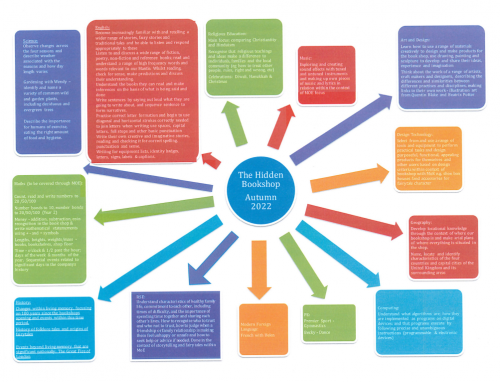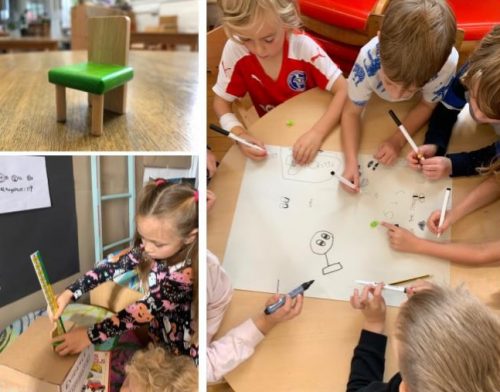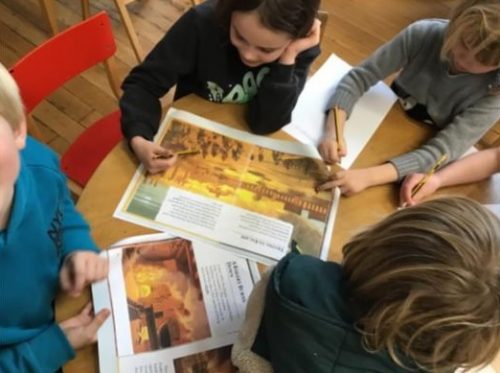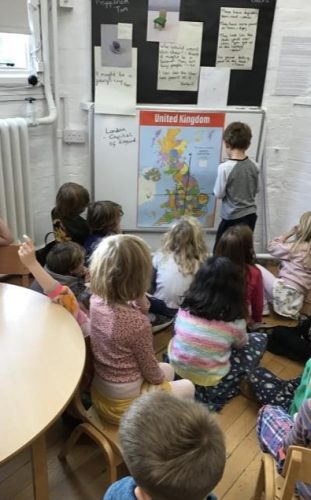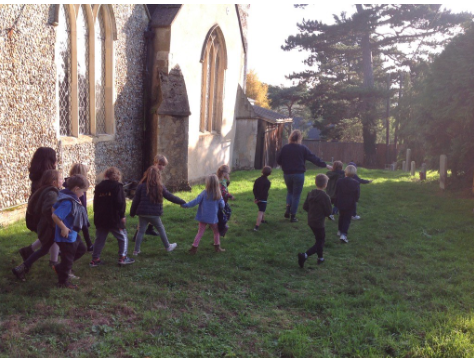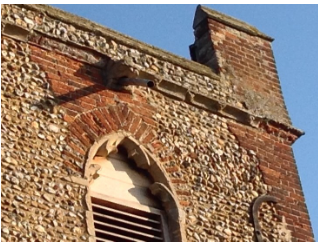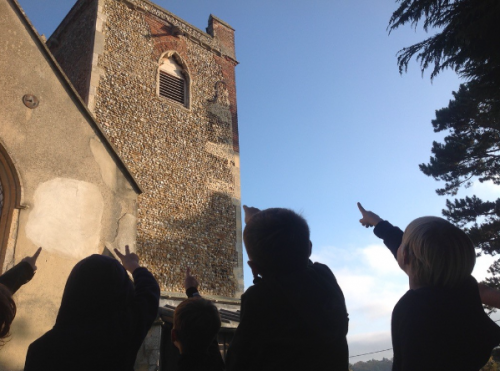Weeks 1 and 2
Welcome back to another exciting year at Bealings! Children arrived in the classroom today to find a letter inviting us to celebrate a century of our bookshop being open. This lead to a number of questions and observations:
With these ideas and initial thoughts, we put together a list of job roles that we would have if we are running a bookshop. We could be cashiers, shop staff, shelf builders, authors and illustrators. We created our own profiles and wrote about what our specific job role is, and how long we have been working for our company. Next came the task of deciding the bookshop name – as a team we came up with a great deal of ideas to vote on!
Eventually we decided on the name ‘The Hidden Bookshop’.
We created a timeline to show 100 years since our bookshop opened, and found that one decade is the same as 10 years, one century is the same as 100 years and one millennium is the same as one thousand years! We marked important events within our bookshop within the past 100 years, and also found that one century is the same as ten decades.
Thinking about the 100 years that we have had at the shop and our own time working there, we reflected on our thoughts and feelings around being here for such a special time. We voiced our feelings of happiness, pride, and enthusiasm and wrote about this too.
To add more excitement and magic to our shop, we have all taken on the roles as authors and are writing our very own story books that will be on display throughout the shop!
Weeks 3 and 4
Invitations needed to be sent out for our celebration, and plans needed to be put in place. We collaboratively wrote out invitations to send to people, and made lists of supplies that we would need. We sorted out how we could categorise books into different groups depending on genre, colour or size, and counted how many books would be in each of these groups.
The celebration party was a great success, with each team member receiving an award for their continued efforts in the bookshop followed by snacks and music!
It was at this point that we started to notice a strange, unknown tapping sound from within our shop. After discussing our initial thoughts, it seemed logical to install an audio recorder within our bookshop to detect any sound whilst we are not on the premises.
The sound recorder quickly picked up this tapping noise, and we set out trying to investigate what the sound could be. Our mutual thought is that the sound is coming from a person or an animal. We talked about our different theories and shared our ideas and questions:
We have now had to take on the role of detectives within our bookshop to try to establish what is going on. After checking the shop for more clues, we came across some other pieces
of evidence. These included a small chair, cup and shoes, and some money. We split up into small groups to discuss and write down further clues, and counted up how many coins were left and what this adds up to.
Weeks 5 and 6
The discovery of the small objects found in the bookshop have stirred up new questions and ideas around the intruder in our shop. We are now keeping track of stock in the shop and using the clock to check our times entering and leaving the bookshop.
Going into role as detectives and examining the evidence further, we have installed an evidence box within our shop and thoughts have turned to why the objects are so small and who would need these.
We started comparing sizes of the objects to other things that we use to try and give us an idea of the size of the person that might be using these. The chair, cup and shoes all point towards a person who we decided would probably be between 7 and 12 centimetres. Using a ruler, we measured what this would be, and found objects in the shop that would be a similar size to this and recorded our findings. We had a few different ideas – the person could be as tall as our hand, a mug, a glue stick or a crayon.
We are wondering if it is indeed a borrower that is taking shelter in our bookshop, though we cannot be sure yet. With this in mind we individually wrote letters to this person, asking what they were doing in the shop and assuring them we were not going to hurt them.
An overheard conversation from a customer in the bookshop has led to even more information being shed on the intruder. We observed a phone call that a customer (teacher in role) made to their mum, explaining how they had ‘the strangest experience at the Hidden Bookshop’, and saw a small man dart in-between books and then hide when he realised that he was visible to other people. The customer described how initially, she thought it was a mouse as it was so small, but soon noticed his old jacket and boots.
Using this new information and description of the intruder, we individually created identikits of the person in question, and put these around the shop to try and appeal to anyone who might have seen him. We also used this opportunity to create some Kennings poetry. Kennings are a figure of speech that were originally used in Anglo Saxon and Old Norse poetry. They are a two word phrase to describe something – for example ‘mouse chaser’, or ‘cunning purer’ for cat. In this instance, we created Kennings for the bookshop intruder. Some of these included:
“A bookshop-supriser”
“A tiny-shuffler”
“A quiet-worker”
“A night-hider”
“A shelf-creeper”
“A Storytime-traveller”
Weeks 7 and 8
Further discussion has ensued when trying to think about how we can deal with the intruder, so we have decided to install security cameras within the shop to try and obtain footage of them. We created a map of the bookshop, and added coordinates on to plot where each piece of evidence was found.
Going back to our estimated height of the intruder, we found that individually our most common estimation was 11cm. This got us thinking about what our individual heights are and how we can find this out. We used metre sticks and tape measures and children measured their heights. We then found the median height out of everyone in the class, and used that as a base to compare our height to the height of the intruder. We found that it would take about 11 of the intruder to make up the height of one of us!
We then translated this to think about how we would feel if we met someone 11 times bigger than us. We set ourselves out on the playground and measured the length of 11 of us put together. This came to about 13 metres in length!
Security footage in our bookshop has detected an alarming sight – a still image of a small person by one of our bookshelves.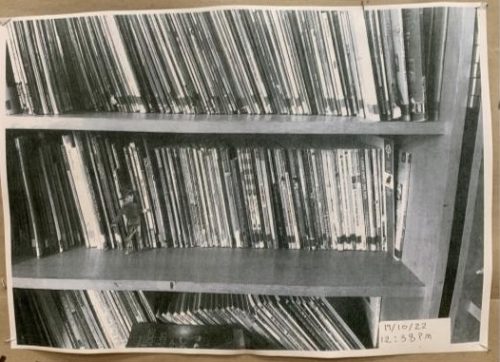
Children decided to hold a company meeting and discussed their theories on who this person is. On searching the bookshop to try and find this person, an old book called ‘The adventures of Tom Thumb’ has appeared, and we believe that we have matched the person in the picture to this book. Children left letters around the shop asking if we are correct in believing that this might be Tom, and promptly received a reply on a tiny piece of paper.
Children wrote out questions to ask the person, and eventually met (teacher in role) the intruder.
At last, we were able to gain some clarity on the sitation in our shop. With the childrens questions prepared, we were able to confirm that it is indeed Tom Thumb living in our bookshop. Throughout the discussion he kept referencing a fire that happened many centuries ago and reuined his home and city. He fled here to escape it, and being a fairytale character, has been living in our shop ever since.
After the meeting, we discussed as a team these two key findings: Tom Thumb is a fairytale character, and he fled a huge fire that he said happened over three centuries ago.
Children then discussed in groups what a fairytale is and what fairytales we know of. Some examples that children came up with included Cinderella, Snow White, The Elves and the Shoemaker, Pinnochio and Rumpelstiltskin. We talked about how fairytales tend to be short stories that have existed through differentn generations and typically feature magical themes.
Next mystery to solve is thinking about this fire that forced Tom to flee over three hundred years ago. Our timeline only shows the past 100 years which does not cover enough time, so we knew it would have happened long before the year 1922. Counting backwards, we found that the fire would have likely happened at some point during the 1600s. We researched and found some history books to search through and see if there were any references to a fire, and in one particular book found out about a fire that happened in 1666 known as The Great Fire of London.
We soon found that the fire occured in a bakery, on a road called Pudding Lane. Children indivually read up on The Great Fire of London and discussed the effect this caused and
what London was like at that time compared to nowadays. Each child then created a detailed pencil drawing of what we know London looked like that time, then afterwards drew using a black marker over acetate what London looks like today.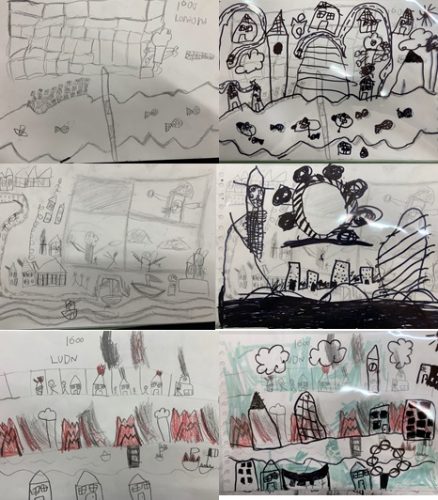
Using a map of the UK, we found and then highlighted where London is, and then also did this for where our bookshop is in Bealings to think about how long Tom’s journey would have been and different possible routes.
Weeks 9 and 10
Knowing more information about Tom Thumb, and thinking about how he told us he fled his home due to fire, we have decided to build a small sized within the bookshop for him to comfortably live in. As a team we discussed what rooms in a house we would need to build and how to make these both functional and homely for our guest. Then in smaller groups we began writing and drawing out our designs, and planned what materials we would use and how the rooms would be constructed.
The rooms were then created in groups using a range of different materials and technique, using cutting and joining to make different parts. Once they were completed, we evaluated our creations, thinking about what went well and what we would change if we were to do this in future.
We also looked at pricing up some of the books in our shop. Using our knowledge on coins and addition, we worked together to find different combinations for the price of books – for example, a book worth 50 pence could be paid for using a range of different coins – fifty 1p coins, or a 20p coin, another 20p coin and a 10p coin.
We were very lucky to have author James Campbell visit our bookshop! James told us all about how he became and author and what inspires him. He also shared some of his funny stories and found out all about what we have been working on in our own bookshop. Everyone thoroughly enjoyed his visit, and individually wrote thank-you letters.
Weeks 11 and 12
Now that we know that Tom Thumb has settled into his new home set up in our bookshop, we talked about the effects that the Great Fire of London must have had on individuals that experienced it and how they must have felt. With the use of dramatic convention, we put ourselves in the shoes of someone in London in 1666, taking into consideration their actions, thoughts and feelings at waking up and realising they had to flee due to fire. We then wrote out diary entries dated 3rd September 1666, involving these details.
When looking at pictures depicting the Great Fire of London, we noticed some interesting stone figures on some buildings, in particular churches. Looking further into this, we found that these are called gargoyles, and their purpose is to convey water away from a building. These are often seen in old churches as they were believed to scare off unwanted spirits. We took a walk around Bealings church to look for gargoyles, and found some on the roof tower:
From this, we looked into Christianity and the features of a Christian church. In the spirit of the season, we also found out about the Christmas story, which ties in with our wonderful KS1 nativity that we have been working on!
We wish you all a very merry Christmas and look forward to seeing you all in 2023!
